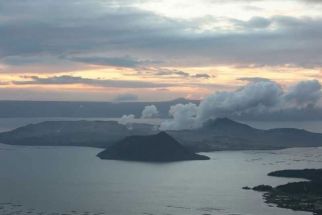Nearly three years after oil spill, Guimaras residents still hopeful
GUIMARAS, Philippines – The thick, black, smelly bunker fuel may have already vanished in the sea but nearly three years after the tragic oil spill that hit this island, residents still reel from its impact, even as they try to carry on with their lives.
To this day, Nanoy Celiz, 46, said he and other fishermen still struggle to make ends meet, as fish catch remains scanty compared to what they had before the so-called biggest sea disaster in Philippine history occurred.
Celiz, now a councilman of Barangay La Paz, recalled their attempt to go about their daily fishing routine that fateful day – Aug. 11, 2006 – when they discovered the unusually greasy ocean water, which yielded practically dead marine animals.
Later, Celiz learned from radio reports that the uncanny quality of the ocean water was due to a sea mishap, involving MT Solar I, which sank near this island province.
According to Celiz, compensation given by Petron Corp. and the International Oil Pollution Compensation Fund, even the livelihood projects extended to affected residents by the government, seemed not enough to pull them out of their poverty.
“We’re surviving now, but he have not fully recovered. But we are trying to carry on despite our situation,” he said in Filipino.
MT Solar I, owned by Sunshine Maritime Development Corp. (SMDC) and chartered by Petron Corp., was carrying 13,000 barrels or at least two million liters of industrial oil when it sank near Guimaras while en route to Zamboanga from Bataan.
The oil spill affected thousands of families, as it destroyed vast areas of mangroves where fish propagate, and other natural resources, including corals.
The tragedy left many locals, who largely depended on the abundance of the sea, with no income since the oil spill resulted in a months-long fishing ban.
Further, as a consequence of the disaster, marine products harvested off the coast of this province were considered unsafe for consumption due to possible contamination.
Inadequate funds for rehab, livelihood
The Department of Environment and Natural Resources (DENR) in Region 6 said it has an approved allocation of at least P65.7 million from the national government’s calamity fund for its rehabilitation efforts in the provinces of Iloilo and Guimaras.
This budget was earmarked for various rehabilitation and livelihood projects. The DENR, among others, worked on the restoration of the affected mangroves, planting new propagules in 30 barangays here and in the barangays of Ajuy and Concepcion in neighboring Iloilo, and revived the Tabon Bird Sanctuary and other threatened wildlife in the affected communities.
The DENR-Region 6 said it also initiated, among others, the production and utilization of sibukao (false sandalwood) in Barangay Taminla and bamboo production and processing in Barangay Dagsaan, both in Buenavista town; as well as the production of medicinal plants and small-scale lime, fish drying, and eco-park development in this province.
In Iloilo, the DENR-Region 6 said it initiated livelihood projects such as abalone and mud crab culture, ginamos making, and banca service, among others.
DENR regional technical director Alicia Lustica, however, said the P65.7-million fund is insufficient to expedite rehabilitation efforts and maximize the benefits of livelihood projects for the affected communities.
Lustica noted that in reality, only a total of P25.262 million was actually disbursed to DENR-Region 6 by the Department of Budget and Management as of March this year.
Lustica said the DENR originally proposed a budget of P120 million per year to efficiently carry out the rehabilitation programs for Guimaras and Iloilo, based on their actual assessment of the damage of the oil spill in the two provinces.
Had the national government approved the DENR’s requested budget, she said the rehabilitation efforts could be fully implemented in five years from 2006.
But the provincial government earlier had questioned the DENR’s priority areas for its projects, claiming that most of the initiatives appeared to have benefited even communities hardly affected by the oil spill.
For instance, it said Buenavista town on the northeast part of Guimaras was barely hit by the disaster.
The DENR projects, the provincial government said, should be focused on the towns of Nueva Valencia, said to be worst hit by the disaster; and Sibunag, which was similarly affected since the oil spill occurred in the island’s southwest portion.
However, Lustica defended the project areas, insisting that beneficiaries in Buenavista were also affected by the oil spill, and that other agencies have projects, too, in Nueva Valencia, which the DENR does not want to duplicate.
Lustica said the livelihood projects in Barangays Taminla and Dagsaan benefited 150 residents and 60 households, respectively.
“We only managed to prioritize certain projects based on the available funds that we have,” Lustica said.
“In five years (from 2006), we could have finished all the programs if the national government only approved our P120 million per year proposed budget for these efforts,” she added.
Keeping a positive attitude
But while the DENR hopes for more funds to fully carry out its rehabilitation and livelihood programs, Celiz and other Guimarasnons are praying for a miracle.
Celiz is hopeful that the government would urgently give them more access to the calamity fund and greater subsidy for alternative livelihood.
In the meantime, Celiz said they are clinging on to their faith and keeping a positive attitude to carry on with their lives.
If there should be any lesson learned from the oil spill, he said it is that people should value their environment.
He said he now realizes the importance of mangroves and corals to fishing, which used to be their main source of livelihood.
Celiz called on his constituents to volunteer in the rehabilitation of mangroves, especially since Barangay La Paz partly hosts the Taklong Island National Marine Reserve, together with Barangay San Roque.
The marine reserve has a total area of 1,143.045 hectares, covering 46 islets in Nueva Valencia town.
Lustica estimates that some 70 to 80 percent of at least 1,000 hectares of mangroves affected by the oil spill have been rehabilitated.
Meanwhile, of the 59 water quality monitoring stations put up following the oil spill, Lustica said only those in Nueva Valencia and Sibunag remain way above the standard of three micrograms per liter, based on oil and grease content.
However, Lustica said water quality in these areas is classified as “SB,” which means the water is fit for tourism activities, thus the eco-tourism project is partly focused on the two towns.
“They said it would take 30 to 50 years for the affected mangroves to completely recover, that’s why we are doing what we could now,” Celiz said in Filipino.
“Even if we could no longer see that, we hope the abundance of the sea would return for our children and the future generations because fishing is really our livelihood here,” he added.
- Latest
- Trending




























